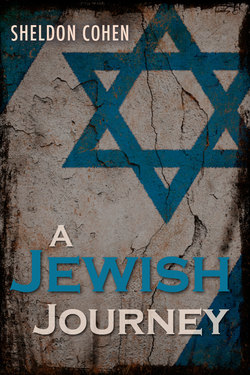Читать книгу A Jewish Journey - Sheldon Cohen - Страница 12
На сайте Литреса книга снята с продажи.
CHAPTER 2 In 1772, Russia, Austria and Prussia divided Poland between them in three stages, over a period of twenty-three years, and Rabbi Tepperovitch’s ancestors found themselves part of Russia. These partitions resulted in Russia assimilating several million Polish Jews within their boundary. Many of the Jews were poor, and some comprised the middle class between the nobility and the peasantry of Russia.
ОглавлениеAt first, the Russian government tried to ignore them even though it was against government policy to have them within their borders, but in time, the government found the Jews useful, blaming them for the untenable economic position of the peasants. As a result, the condition of the Jews became precarious. The peasants persecuted them and government put restrictions on them that made their lives difficult.
The Pale of Settlement was the name for the entire landmass within which the Jews lived. As time went on the geographic boundaries of the Pale would change, and the population of the Pale increased to almost five million by nineteen hundred.
They lived in shtetles, the Yiddish name for small towns. Their homes were made of wood, and three generations often lived under the same roof. The roads were dirt or cobblestone, and transportation was by foot, horse, or horse-drawn carriage.
The residents formed a close community; they congregated together, communicated with neighboring shtetles and did business with each other and their Christian neighbors. Some shtetles had Jewish majorities and others did not. The Jews were bound to each other by a common language—Yiddish.
The fact that the Jews kept to themselves and spoke this unfamiliar tongue, caused them to be viewed by non-Jewish members of the community as foreigners living within their midst. This was often the source of tension between the Jews and their Christian neighbors.
Tiktin was a typical small Polish town. Located in northwest Poland in the province of Bialystok almost fifty percent of the population was Jewish.
Anti-Semitism amongst the Christian townspeople caused constant tension in the Jewish community. There were frequent incidences of Jews assaulted on the streets and Jewish homes victimized by vandalism. Jews had learned from bitter experience to stay behind locked doors during the Easter and Christmas seasons when drunken, roving bands of armed peasants took out their enmity against the ‘Christ killers.’
The Jews were of the poorer and middle class. They were shopkeepers, merchants, tailors, shoemakers, seamstresses and laundresses. Many worked in factories or mills and a few worked in the synagogue. A rare few became wealthy and played an important role in business and community life. In spite of the fact that the Jews had lived in tyranny through a succession of Russian Czars, democracy reigned throughout the Jewish community.
For the Jewish community the most important building in the shtetles of the Pale was the synagogue. Their construction consisted of brick and stone, or wood. Many were beautiful examples of contemporary or older style architecture. The synagogue served as the religious center of the community. Here Jews congregated regularly for prayer, commemorated a long list of Jewish holidays and educated their youth.
The synagogue of Tiktin, one of Poland’s oldest, constructed in 1642, looked like a fortress and had a long spiral staircase leading to a turret on the roof for scouting approaching enemies. To enter the synagogue one had to descend seven steps representing seven letters in the Hebrew word Memaamakim meaning from the depth: “From the depth I called to You, Oh God.” Next to the entrance, there was a wide slit in the wall covered with iron bars, which served as the opening of the tzeddakah (charity) box. Over the box was a poem written by the Ibn Ezra, a great eleventh and twelfth century Jewish man of letters. It said:
A person frets over the loss of his money,
But does not fret over the loss of his days,
Yet his money will not help him,
And his days will not return to him.
Charity redeems from death.
Rabbi Shepsel Tepperovich was the only rabbi in Tiktin, and he was the source of all Torah wisdom for the fifty percent of its citizenry that were Jewish.
Next to the old Synagogue was a small house where Jewish men gathered to study the Torah, and where Jewish youth learned Hebrew, Jewish history, lore and culture.
In 1843, Nicholas I was Czar of Russia. He characterized the Jews as “the leeches of the country.” He had instituted one of the most onerous laws in Jewish history when, in 1827, he decreed that once a Jew reached the age of twelve, he was required to serve in the Russian army for twenty-five years. At twelve, he attended the same schools as the Russian soldier’s sons. The purpose was simple; while serving in the military, a Jew had the option to convert or die.
In general, Jews had to endure ill treatment by their officers. Priests subjected them to various tortures in order to accept baptism. They were awakened in the middle of the night and compelled to kneel until they accepted conversion or collapse; they were given high salt meals and denied water; they were beaten and tortured, and it was the rare recruit who was able to hang on to his faith.
Jewish communities had a quota of Jewish twelve-year-olds to supply to the military. This quota was a certain number of conscripts per each thousand males. Who would go? Who would not go? In some areas, children of the poorest Jews were forced into service. Influential Jewish leaders had this task and hired ‘khapers’ to fill the quota. In essence these hired men were salaried kidnapers.
The Jewish conscripts were kept in cantonments and as a result they were called cantonists.
